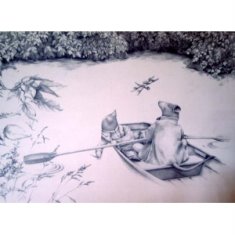 I think that we should never feel that we are too old to rediscover (or maybe discover for the first time) children’s books.
I think that we should never feel that we are too old to rediscover (or maybe discover for the first time) children’s books.Even if I go on to attain turtle-like longevity I am already well into the second half of my lifetime, and yet I continue to read children’s books. I make it a point to do so. And I will continue to do so as long as I have the eyesight.
For one thing, it keeps the wrinkles off.
And of all the children’s books I have read, I think that my favorite has been Kenneth Grahame’s The Wind in the Willows, first published in 1908.
I, a reluctant grown-up, confess that my life has been enriched through my meeting of these four Edwardian animal bachelors.
The Wind is a classic that should be read TO or BY anyone YOUNG or OLD enough to have an imagination! Grahame created a wonderful pastoral world where the River-Bankers (consisting of Rat, Mole, Badger, and Otter) and their friends form a close-knit community of leisured landowners who observe an extremely strict code of responsible behavior.
Uh... then there's Toad.
Toad, although he is one of the River-Bankers, continually distinguishes himself as one who is conceited and irresponsible, a spendthrift megalomaniac who disgraces his friends by even landing himself in jail. Because of his incarceration, the stoats and weasels of the Wild Wood attempt to invade Toad's ancestral home, and this threat to River-bank society is the one thing that can rouse Badger out of his cosy retirement. Together, he and Rat lecture Toad with the inflexible moral fervor of Alcoholics Anonymous.
Will Toad ever come to a sincere repentance and reform? Well, that is the question.
Throughout the whole book there runs the leitmotif which may be roughly described as the conflict between Us and Them - or more specifically, the attempts made by Grahame's ideal rural society to defend itself against encroachment. I personally believe that this subtle theme can be a great vehicle to instill in the young reader (or listener) a sense of the importance of peaceful living, and of how our actions affect others. Adult readers will definitely have lived long enough to clearly recognize themselves in one of the main animal characters.
Alas... I am undoubtedly Toad!
The Willows series has been serialized by the author William Horwood (published by HarperCollins) and I have read all of these sequels: The Willows and Beyond, Toad Triumphant, The Willows in Winter, and The Willows at Christmas.
All of them are superb.
As in A+.
When I contemplate the reading of children’s books, I cannot help but think of another favorite author of mine, C.S. Lewis, creator of The Narnia Chronicles.
Soon, very soon, in the 2005 Christmas season, his The Lion, The Witch and the Wardrobe will be in the theatres, and I will be first in line to see it. At any rate, Lewis (1898-1963) has written at length on the adult value of reading children’s literature. Here are just a few Lewis quotes, culled at random from different sources.
No book is really worth reading at the age of ten which is not equally (and often far more) worth reading at the age of fifty--except, of course, books of information. The only imaginative works we ought to grow out of are those which it would have been better not to have read at all.
...a children's story which is only enjoyed by children is a bad children's story.
When I was ten, I read fairy tales in secret and would have been ashamed if I had been found doing so. Now that I am fifty, I read them openly. When I became a man, I put away childish things, including the fear of childishness and the desire to be very grown up.
Those of us who are blamed when old for reading childish books were blamed when children for reading books too old for us. No reader worth his salt trots along in obedience to a time table.
And I think it possible that by confining your child to blameless stories of child life in which nothing alarming ever happens, you would fail to banish the terrors, and would succeed in banishing all that can ennoble them or make them endurable. For, in the fairy tales, side by side with the terrible figures, we find the immemorial comforters and protectors, the radiant ones; and the terrible figures are not merely terrible, but sublime.
Once in a hotel dining-room, I said, rather too loudly, "I loathe prunes."
"So do I" came an unexpected six-year-old voice from another table. Sympathy was instantaneous. Neither of us thought it funny. We both knew that prunes are far too nasty to be funny. That is the proper meeting between man and child as independent personalities.
*******
No comments:
Post a Comment